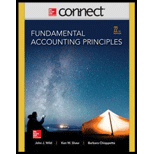
Concept Introduction:
Acid test ratio: Acid test ration is also called Quick ratio. This ratio is calculated by dividing the quick assets (Cash, Cash equivalents, Short term investments and current receivables) by total current liabilities for the year. The formula for Acid test ratio is as follows:
Days Sales in receivable ratio: This is an efficiency ratio that indicates the period for which credit sales remain as receivable. The ratio is calculated by dividing 365 days by the Accounts receivable turnover ratio. The formula to calculate this ratio is as follows:
Inventory Turnover Ratio: Inventory Turnover Ratio measures the efficiency of the company in converting its inventory into sales. It is calculated by dividing the Cost of goods sold by Average inventory. The formula of the Inventory Turnover Ratio is as follows:
Note: Average inventory is calculated with the help of following formula:
Day’s sales in inventory: Days sales in inventory represent the number of days the inventory waits for the sale. It is calculated by dividing the 365 days by Inventory Turnover Ratio. The formula of the Days sales in inventory is as follows:
Profit Margin Ratio:
Profit Margin Ratio is a profitability ratio that represents the percentage income earned on the sales. It is calculated by dividing the Net Income by the Sales. The formulas to calculate the Profit margin is as follows:
Asset Turnover Ratio:
Asset Turnover Ratio is an efficiency ratio that represents the sales earned on the average assets invested in the business. It is calculated by dividing the Sales by Average total assets. The formulas to calculate the Asset Turnover Ratio is as follows:
Return on total Assets: The Return on total assets is profitability ratio that measures the percentage of profit earned on average assets invested in the business. Return on asset is calculated by dividing the net income by average total assets. The formula to calculate Return on assets is as follows:
Note: Average total assets are calculated as an average of beginning and ending total assets. The formula to calculate the average total assets is as follows:
Return on Common Stockholder’s Equity:
Return on Equity is the rate of return earned by the Stockholders on their investment in the company. It is calculated with the help of following formula:
The Average stock holder’s equity calculated with the help of following formula:
Price Earnings Ratio:
The price earnings ratio shows the relationship between price of the share and earnings per share. It is calculated with the help of following formula:
Dividend Yield Ratio:
Dividend Yield ratio is calculated as percentage by dividing the Dividend per share by Market price per share. The formula for the Dividend Yield ratio is as follow:
Requirement-1:
To determine: Current ratio, acid test ratio, accounts receivable turnover, inventory turnover, and day’s sales in inventory and, days sales uncollected for both the companies.
Requirement-2:
To determine: Profit margin ratio, total asset turnover ratio, return on total asset, return on common stock holder’s equity, price earnings ratio and, dividend yield for both the companies.
Want to see the full answer?
Check out a sample textbook solution
Chapter 17 Solutions
FUND.ACCT.PRIN -ONLINE ONLY >I<
- Questin 5arrow_forwardBelle Garments manufactures customized T-shirts for football teams. The business uses a perpetual inventory system and has a highly labour-intensive production process, so it assigns manufacturing overhead based on direct labour cost. The business operates at a profit margin of 33% on sales. Belle Garments expects to incur $2,205,000 of manufacturing overhead costs and estimated direct labour costs of $3,150,000 during 2025. At the end of December 2024, Belle Line Garments reported work in process inventory of $93,980 - Job FBT 101 - $51,000 & Job FBT 102 - $42,980 The following events occurred during January 2025. i) Purchased materials on account, $388,000. The purchase attracted freight charges of $4,000 ii) Incurred manufacturing wages of $400,000 iii) Requisitioned direct materials and used direct labour in manufacturing. Job # FBT 101 FBT 102 FBT 103 FBT 104 Direct Materials $70,220 97,500 105,300 117,000 iv) Issued indirect materials to production, $30,000. Direct Labour $61,200…arrow_forwardThe trial balance for K and J Nursery, Incorporated, listed the following account balances at December 31, 2024, the end of its fiscal year: cash, $27,000; accounts receivable, $22,000; inventory, $36,000; equipment (net), $91,000; accounts payable, $25,000; salaries payable, $10,500; interest payable, $6,500; notes payable (due in 18 months), $41,000; common stock, $72,000. Determine the year-end balance in retained earnings for K and J Nursery, Incorporated.arrow_forward
- Brun Company produces its product through two processing departments: Mixing and Baking. Information for the Mixing department follows. Direct Materials Conversion Unit Percent Complete Percent Complete Beginning work in process inventory 7.500 Units started this period 104,500 Units completed and transferred out 100.000 Ending work in process inventory 12.000 100% 25% Beginning work in process inventory Direct materials Conversion $6.800 14.500 $21.300 Costs added this period Drect materials 116,400 Conversion Total costs to account for 1.067,000 1.183.400 $1.204.700 Required 1. Prepare the Mixing department's production cost report for November using the weighted average method Check (1) C$1.000 2. Prepare the November 30 journal entry to transfer the cost of completed units from Mixing to Bakingarrow_forwardNonearrow_forwardNot need ai solution please solve this general accounting questionarrow_forward

 AccountingAccountingISBN:9781337272094Author:WARREN, Carl S., Reeve, James M., Duchac, Jonathan E.Publisher:Cengage Learning,
AccountingAccountingISBN:9781337272094Author:WARREN, Carl S., Reeve, James M., Duchac, Jonathan E.Publisher:Cengage Learning, Accounting Information SystemsAccountingISBN:9781337619202Author:Hall, James A.Publisher:Cengage Learning,
Accounting Information SystemsAccountingISBN:9781337619202Author:Hall, James A.Publisher:Cengage Learning, Horngren's Cost Accounting: A Managerial Emphasis...AccountingISBN:9780134475585Author:Srikant M. Datar, Madhav V. RajanPublisher:PEARSON
Horngren's Cost Accounting: A Managerial Emphasis...AccountingISBN:9780134475585Author:Srikant M. Datar, Madhav V. RajanPublisher:PEARSON Intermediate AccountingAccountingISBN:9781259722660Author:J. David Spiceland, Mark W. Nelson, Wayne M ThomasPublisher:McGraw-Hill Education
Intermediate AccountingAccountingISBN:9781259722660Author:J. David Spiceland, Mark W. Nelson, Wayne M ThomasPublisher:McGraw-Hill Education Financial and Managerial AccountingAccountingISBN:9781259726705Author:John J Wild, Ken W. Shaw, Barbara Chiappetta Fundamental Accounting PrinciplesPublisher:McGraw-Hill Education
Financial and Managerial AccountingAccountingISBN:9781259726705Author:John J Wild, Ken W. Shaw, Barbara Chiappetta Fundamental Accounting PrinciplesPublisher:McGraw-Hill Education





